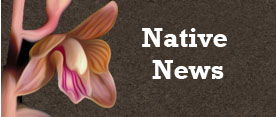NC Native Plant Society:
Plant Details
Viburnum lantanoides [= Viburnum alnifolium]
Hobble-bush, Witch-hobble, Moosewood
Scientific Name: |
Viburnum lantanoides [= Viburnum alnifolium] |
|---|---|
Genus: |
Viburnum |
Species Epithet: |
lantanoides |
Common Name: |
Hobble-bush, Witch-hobble, Moosewood |
Plant Type |
Shrub |
Life Cycle |
Perennial |
Plant Family |
Viburnaceae (Viburnum Family) |
Native/Alien: |
NC Native |
Invasive Status: |
(*Key) |
Size: |
3-6 ft., 6-12 ft. |
Bloom Color(s): |
White |
Light: |
Part Shade - 2 to 6 hours of sun per day |
Soil Moisture: |
Moist |
Bloom Time: |
April, May, June |
Growing Area: |
Mountains |
Habitat Description: |
Spruce-fir forests, northern hardwood forests, and boulderfields per Weakley. |
Leaf Arrangement: |
Opposite |
Leaf Retention: |
Deciduous |
Leaf Type: |
Leaves veined, not needle-like or scale-like |
Leaf Form: |
Simple |
Life Cycle: |
Perennial |
Wildlife Value: |
Important for Wildlife |
Landscape Value: |
Not Recommended for home landscapes |
State Rank: |
S4: Apparently secure (*Key) |
Global Rank: |
G5 - Secure (*Key) |
Federal Status: |
(*Key) |
Notes: |
Viburnum lantanoides is found in the mountains of North Carolina, usually at elevations above 4,000 feet and more common at higher elevations. The species is much more common in northern states where masses occupy the understory and justify the name "hobble-bush". |
|
Hobble-bush is limited to higher elevations in the North Carolina mountains. Paired leaves unfurl from large buds in mid-April.
Will Stuart |
|
|
Leaves are large, heart-shaped with cordate bases, beautifully textured, and arranged 2 per node along arching branches.
Will Stuart |
|
|
The inflorescence is a flat-topped cluster of small fertile flowers surrounded by larger, showy, white, sterile flowers.
Will Stuart |
|
|
Fruits develop in mid-summer, turning red by late summer and later turning deep blue.
Will Stuart |
|
|
The leaves of Viburnum lantanoides have wonderful fall color turning bright crimson in sunnier locations.
Will Stuart |
|
|
Immature fruit (drupes) are green which ripen to red then blue NC mountains
Bettina Darveaux |
|
Links: |
|
back to top
go to plant details search
go to plant images search
go to gallery home
back to Initial v Gallery
back to orchids
back to Carnivorous Plants
back to Trilliums

![Hobble-bush is limited to higher elevations in the North Carolina mountains. Paired leaves unfurl from large buds in mid-April. of Viburnum lantanoides [= Viburnum alnifolium] The Scientific Name is Viburnum lantanoides [= Viburnum alnifolium]. You will likely hear them called Hobble-bush, Witch-hobble, Moosewood. This picture shows the Hobble-bush is limited to higher elevations in the North Carolina mountains. Paired leaves unfurl from large buds in mid-April. of Viburnum lantanoides [= Viburnum alnifolium]](https://ncwildflower.org/images/plants/Viburnum_lantanoides_20120419_0022.jpg)
![Leaves are large, heart-shaped with cordate bases, beautifully textured, and arranged 2 per node along arching branches. of Viburnum lantanoides [= Viburnum alnifolium] The Scientific Name is Viburnum lantanoides [= Viburnum alnifolium]. You will likely hear them called Hobble-bush, Witch-hobble, Moosewood. This picture shows the Leaves are large, heart-shaped with cordate bases, beautifully textured, and arranged 2 per node along arching branches. of Viburnum lantanoides [= Viburnum alnifolium]](https://ncwildflower.org/images/plants/Viburnum_lantanoides_20120419_0024.jpg)
![The inflorescence is a flat-topped cluster of small fertile flowers surrounded by larger, showy, white, sterile flowers. of Viburnum lantanoides [= Viburnum alnifolium] The Scientific Name is Viburnum lantanoides [= Viburnum alnifolium]. You will likely hear them called Hobble-bush, Witch-hobble, Moosewood. This picture shows the The inflorescence is a flat-topped cluster of small fertile flowers surrounded by larger, showy, white, sterile flowers. of Viburnum lantanoides [= Viburnum alnifolium]](https://ncwildflower.org/images/plants/Viburnum_lantanoides_20130506_0174.jpg)
![Fruits develop in mid-summer, turning red by late summer and later turning deep blue. of Viburnum lantanoides [= Viburnum alnifolium] The Scientific Name is Viburnum lantanoides [= Viburnum alnifolium]. You will likely hear them called Hobble-bush, Witch-hobble, Moosewood. This picture shows the Fruits develop in mid-summer, turning red by late summer and later turning deep blue. of Viburnum lantanoides [= Viburnum alnifolium]](https://ncwildflower.org/images/plants/Viburnum_lantanoides_20110816_0046.jpg)
![The leaves of Viburnum lantanoides have wonderful fall color turning bright crimson in sunnier locations. of Viburnum lantanoides [= Viburnum alnifolium] The Scientific Name is Viburnum lantanoides [= Viburnum alnifolium]. You will likely hear them called Hobble-bush, Witch-hobble, Moosewood. This picture shows the The leaves of Viburnum lantanoides have wonderful fall color turning bright crimson in sunnier locations. of Viburnum lantanoides [= Viburnum alnifolium]](https://ncwildflower.org/images/plants/Viburnum_lantanoides_20131003_0173.jpg)
![Immature fruit (drupes) are green which ripen to red then blue of Viburnum lantanoides [= Viburnum alnifolium] The Scientific Name is Viburnum lantanoides [= Viburnum alnifolium]. You will likely hear them called Hobble-bush, Witch-hobble, Moosewood. This picture shows the Immature fruit (drupes) are green which ripen to red then blue of Viburnum lantanoides [= Viburnum alnifolium]](https://ncwildflower.org/images/plants/IMG_8612.jpg)


